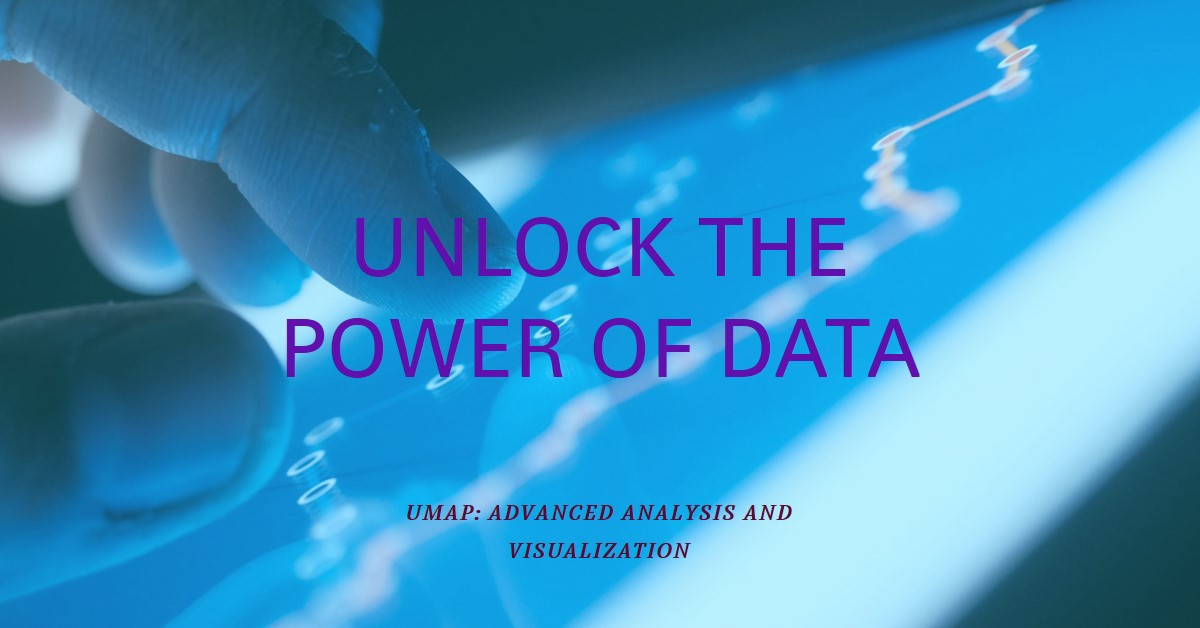
Learn about UMAP (Uniform Manifold Approximation and Projection), a versatile technique for dimensionality reduction. This guide covers UMAPs
Introduction
UMAP (Uniform Manifold Approximation and Projection) is a powerful tool for dimensionality reduction and data visualization. This technique has gained prominence in the fields of data science, machine learning, and artificial intelligence for its ability to transform high-dimensional data into a lower-dimensional space while preserving the data’s structure. This article explores what UMAP is, its key features, applications, and how you can leverage it for your data analysis and machine learning projects.
What is UMAP?
UMAP is a nonlinear dimensionality reduction technique that helps reduce the number of variables in a dataset while maintaining its essential structure and relationships. Developed by Leland McInnes, John Healy, and James Melville in 2018, UMAP is designed to be a versatile and efficient tool for various data analysis tasks. It is particularly useful for visualizing complex datasets and discovering patterns that might not be apparent in higher dimensions.
Key Features of UMAP
1. Dimensionality Reduction
UMAP transforms high-dimensional data into a lower-dimensional representation, making it easier to visualize and interpret complex datasets. This reduction helps in identifying patterns, clusters, and relationships that are not visible in the original high-dimensional space.
- Maintains Structure: UMAP preserves both local and global data structures, unlike some other dimensionality reduction techniques that focus only on local or global properties.
- Versatile Reduction: Supports reductions to any number of dimensions, though common uses include reducing data to 2D or 3D for visualization purposes.
2. Efficient and Scalable
UMAP is designed to be both computationally efficient and scalable:
- Fast Computation: UMAP can handle large datasets with millions of data points efficiently.
- Scalable: The algorithm scales well with increasing data sizes and dimensionalities, making it suitable for both small and large-scale data analysis tasks.
3. Flexible and Configurable
UMAP offers several hyperparameters that can be tuned to fit specific data analysis needs:
- n_neighbors: Controls the size of the local neighborhood used for manifold approximation.
- min_dist: Determines the minimum distance between points in the lower-dimensional space, affecting how tightly the points are packed.
- metric: Specifies the distance metric used to calculate distances between points, such as Euclidean, Manhattan, or cosine similarity.
4. Graph-Based Approach
UMAP employs a graph-based approach to construct a high-dimensional graph representation of the data:
- Graph Construction: Builds a weighted graph representing the data’s high-dimensional relationships.
- Optimization: Uses a stochastic optimization process to find a low-dimensional representation that maintains the high-dimensional graph’s structure.
Applications of UMAP
UMAP’s flexibility and effectiveness make it a valuable tool for a wide range of applications:
1. Data Visualization
UMAP is commonly used to create 2D or 3D visualizations of high-dimensional data:
- Exploratory Data Analysis: Helps in exploring data, identifying clusters, and discovering patterns.
- Feature Reduction: Reduces the number of features for visualization while preserving the data’s structure.
2. Machine Learning
UMAP can be integrated into machine learning workflows for various tasks:
- Feature Engineering: Transforms data into a lower-dimensional space to improve model performance.
- Anomaly Detection: Identifies outliers and anomalies by visualizing data distributions.
- Clustering: Aids in clustering algorithms by providing a reduced-dimensional representation of the data.
3. Bioinformatics
UMAP is widely used in bioinformatics for analyzing complex biological data:
- Single-Cell RNA Sequencing: Visualizes gene expression profiles of single cells to identify cell types and states.
- Genomic Data Analysis: Reduces dimensionality for genomic datasets to uncover biological insights.
4. Natural Language Processing (NLP)
UMAP is used in NLP for tasks involving textual data:
- Text Embeddings: Reduces dimensionality of text embeddings for visualization and analysis.
- Semantic Analysis: Helps in understanding the relationships between different text documents or topics.
How to Implement UMAP
Here’s a step-by-step guide to implementing UMAP in your data analysis projects:
1. Install UMAP
You can install the UMAP library using pip:
bashCopy codepip install umap-learn
2. Import UMAP
Import UMAP in your Python script or Jupyter notebook:
pythonCopy codeimport umap
3. Prepare Your Data
Load and preprocess your data for dimensionality reduction:
pythonCopy codefrom sklearn.datasets import load_iris
data = load_iris()
X = data.data
y = data.target
4. Apply UMAP
Initialize and fit the UMAP model to your data:
pythonCopy codeumap_model = umap.UMAP(n_neighbors=15, min_dist=0.1, metric='euclidean')
X_umap = umap_model.fit_transform(X)
5. Visualize the Results
Create a scatter plot to visualize the 2D representation of the data:
pythonCopy codeimport matplotlib.pyplot as plt
plt.scatter(X_umap[:, 0], X_umap[:, 1], c=y, cmap='Spectral')
plt.colorbar()
plt.title('UMAP Projection of the Iris Dataset')
plt.show()
Best Practices for Using UMAP
To get the most out of UMAP, consider these best practices:
- Experiment with Hyperparameters: Adjust
n_neighbors,min_dist, andmetricto find the best settings for your specific dataset and analysis goals. - Preprocess Your Data: Ensure that your data is clean and normalized before applying UMAP for optimal results.
- Combine with Other Techniques: Use UMAP in conjunction with other dimensionality reduction methods, such as PCA, for more comprehensive data analysis.
Challenges and Considerations
While UMAP is a powerful tool, it’s important to be aware of its limitations and challenges:
- Choosing Parameters: Finding the right hyperparameters can be challenging and may require experimentation.
- Interpretability: Lower-dimensional representations may not always be easy to interpret, especially for complex datasets.
- Computational Resources: Although UMAP is efficient, very large datasets may still require significant computational resources.
Future Directions
UMAP continues to evolve as a tool for data analysis and visualization:
- Algorithm Improvements: Ongoing research aims to improve the efficiency, scalability, and flexibility of the UMAP algorithm.
- Broader Applications: Expanding the range of applications in emerging fields such as quantum computing, advanced bioinformatics, and complex network analysis.
- Integration with Other Tools: Enhancing integration with other data analysis and machine learning tools for more comprehensive solutions.
Conclusion
UMAP is a versatile and powerful technique for dimensionality reduction and data visualization, offering valuable tools for data scientists, researchers, and machine learning practitioners. Its ability to preserve data structure, combined with its efficiency and flexibility, makes UMAP a key tool in the data analysis toolkit. By exploring its features and applications, you can leverage UMAP to gain deeper insights into your data and drive innovation in your projects.
Meta Description
Explore UMAP (Uniform Manifold Approximation and Projection), a powerful tool for dimensionality reduction and data visualization. Learn about its features, applications, and how to implement UMAP for effective data analysis and machine learning projects.
Additional Resources
- UMAP Official Documentation (for detailed documentation and tutorials)
- UMAP GitHub Repository (for source code and contributions)
- UMAP Python Package (for installation and updates)
- UMAP Tutorials and Examples (for step-by-step guides and example implementations)
Feel free to adjust the content based on your specific focus or audience needs!
Additional Examples and Tutorials
Here are a few additional examples and tutorials to help you get started with UMAP:
1. Basic UMAP Example with Scikit-Learn
pythonCopy codeimport umap
from sklearn.datasets import load_digits
import matplotlib.pyplot as plt
digits = load_digits()
X = digits.data
y = digits.target
umap_model = umap.UMAP()
X_umap = umap_model.fit_transform(X)
plt.scatter(X_umap[:, 0], X_umap[:, 1], c=y, cmap='Spectral')
plt.colorbar()
plt.title('UMAP Projection of the Digits Dataset')
plt.show()
2. UMAP for Clustering Analysis
pythonCopy codeimport umap
from sklearn.datasets import load_wine
from sklearn.cluster import KMeans
import matplotlib.pyplot as plt
wine = load_wine()
X = wine.data
y = wine.target
umap_model = umap.UMAP(n_neighbors=10, min_dist=0.2)
X_umap = umap_model.fit_transform(X)
kmeans = KMeans(n_clusters=3)
clusters = kmeans.fit_predict(X_umap)
plt.scatter(X_umap[:, 0], X_umap[:, 1], c=clusters, cmap='Spectral')
plt.title('UMAP Projection with KMeans Clustering')
plt.show()
3. UMAP for Text Data Visualization
pythonCopy codeimport umap
from sklearn.feature_extraction.text import TfidfVectorizer
import matplotlib.pyplot as plt
documents = ["Text data example 1", "Another text example", "UMAP for text data", ...]
vectorizer = TfidfVectorizer()
X = vectorizer.fit_transform(documents)
umap_model = umap.UMAP(n_neighbors=5, min_dist=0.3)
X_umap = umap_model.fit_transform(X.toarray())
plt.scatter(X_umap[:, 0], X_umap[:, 1])
plt.title('UMAP Visualization of Text Data')
plt.show()
These examples illustrate different use cases of UMAP, from visualizing datasets to integrating with clustering algorithms and analyzing text data.
Read More:
RivenisNet: Your Gateway to the Future of Decentralized Finance and Web3 Innovations







